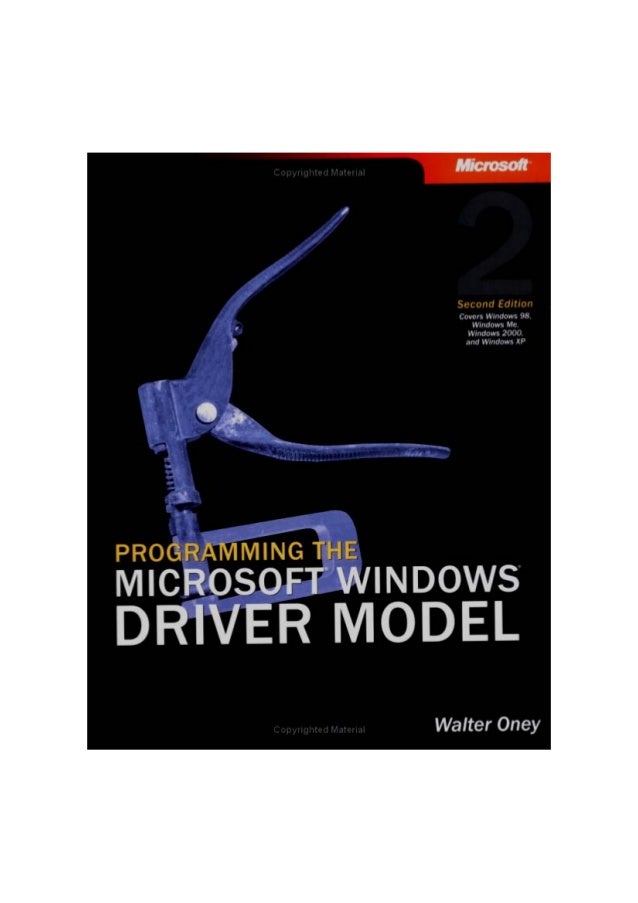Windows Driver Package - Walter Oney Software (dlsusb) Ports ( is a Shareware software in the category Miscellaneous developed by Walter Oney Software. The latest version of Windows Driver Package - Walter Oney Software (dlsusb) Ports ( is currently unknown. It was initially added to our database on. From Programming the Microsoft Windows Driver Model, Second Edition by Walter Oney. HIDMaker creates device firmware and a Windows application from information you provide. Also available are the AnyHID test program and the USBWatch software-only protocol analyzer.
Downloads – Click on the link to download
The PC/SC Workgroup provides this information as a convenience. All links below are external links. Information posted does not constitute an endorsement or guarantee from the PC/SC Workgroup.
Microsoft Logo Program and Driver Signing Overview
Download copy of WDK program, and click on the “Sign In” to register. If you are already registered, click on this link for SIGN IN
Walter Oney Software Usb Devices Driver Download

Sign in to the website and then click on Available Connections. Scroll down to “Microsoft Windows Driver Kit (WDK) Beta Program” and click on “Apply”. Please fill out the surver before downloading bits.
Microsoft Smart Card Developer Tools
Platform builder for Microsoft Windows CE 5.0. To download evaluation copy of Windows CE —Click here.
SDK Web Install
Windows Server 2003 SP1 Platform – April 2005 Edition. Available on Microsoft’s Download Website. You can use this SDK to develop both 32 and 64 bit applications.This SDK is also available as a low-cost CD and can be ordered using this same link. visit http://www.microsoft.com/downloads/ for more information
Walter Oney Software’s Oney CCID driver
Walter Oney Software offers a full-featured driver package for SmartCard readers and tokens conforming to the USB specification for Chip/Smart Card Interface Devices. Fully supports PC/SC Part 10, rev. 2.02.05 (12/08). Their driver is guaranteed to pass all the relevant WHQL tests. Trial version available for free download. Also available is a comprehensive test program for PC/SC Part 10. Visit www.oneysoft.com for more information, or to download software drivers.
Driver Development Tools
Available on Microsoft’s MSDN website. Various tools and drivers for building, testing and debugging code. Visit http://www.msdn.microsoft.com/en-us/library/ for more information.
Linux
A CCID driver is available at http://pcsclite.alioth.debian.org/ccid.html.
See also Ludovic Rousseau’s blog.
Vendors can provide an INF file to install a WBDI driver.
Walter Oney Software Usb Devices Drivers
The following is a list of guidelines for biometric device installation. The code examples in this topic are taken from the WudfBioUsbSample.inx file of the WudfBioUsbSample:
WBDI drivers should specify a class of 'Biometric.' Set ClassGuid equal to the value that corresponds to GUID_DEVCLASS_BIOMETRIC in Devguid.h:
In your .HW section, provide AddReg directives to specify three sections that contain entries to be added to the registry:
Provide the named sections referred to in the .HW section. The [Biometric_Device_AddReg] section sets values for the biometric device, including the exclusive flag and system wake/device idle. To be recognized by Windows Biometric Framework, UMDF-based WBDI drivers must set the 'Exclusive' value to 1. The first two lines of the [Biometric_Device_AddReg] section specify access control list (ACL) rights so that the device can only be opened by an administrator or the local system account. When you specify these ACL rights, third-party applications cannot open the device and capture fingerprint data when the WinBio service is not running. For example:
A WBDI driver that exposes functionality to a legacy (non-WBDI) biometric stack should set the Exclusive value to zero. If this value is set to zero, the Windows Biometric Framework does not attempt to control the device and the device is not exposed through WBF.
Vendors can have a single driver binary that can work with legacy stacks and WBF, but the two cannot operate simultaneously. WBF will only operate if the device can be opened with exclusive access.
The second named section contains registry values for the plug-in adapters. The sample uses the Microsoft-provided sensor adapter and storage adapter. This section also enables Windows log-in support by setting the SystemSensor value:
Finally, the third section sets the following registry values for the database service. The identifying GUID must be unique for each vendor database of a certain format. For instance, in this code example from the sample, change 6E9D4C5A-55B4-4c52-90B7-DDDC75CA4D50 to your own unique GUID in your INF file.
To differentiate WBDI and legacy drivers, vendors must set a Feature Score for the driver in the INX file. Feature Score is not set in the WudfBioUsbSample sample. For more information about setting a Feature Score, see Ranking a Biometric Driver on Windows Update.
For information about INX files and how they differ from INF files, see Using INX Files to Create INF Files.
In order to replace a WBDI driver with a legacy driver, use the following procedure:
Close all currently active WBF applications.
Uninstall the WBDI driver.
Stop the WBF service, restart it, and then stop it again.
Install the legacy driver.

